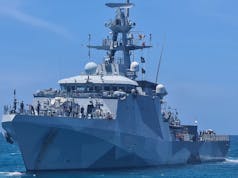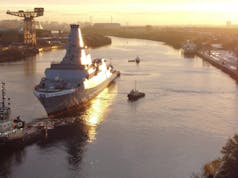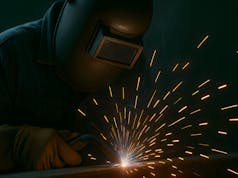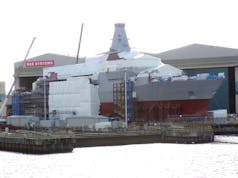In addition to 24 F-35Bs, the carrier air wing of HMS Queen Elizabeth will also feature around 14 helicopters with numbers depending on operational requirements.
Captain Jerry Kyd, commander of HMS Queen Elizabeth, commented on the initial deployment and the gradual increase in air wing numbers:
“We’re constrained by the F-35 buy-rate even though that was accelerated in SDSR in 2015, so initial operating capability numbers in 2020 are going to be very modest indeed. We will flesh it out with helicopters, and a lot depends on how many USMC F-35s come on our first deployment in 2021.
But by 2023, we are committed to 24 UK jets onboard, and after that it’s too far away to say.”
This however assumes that both 617 Sqn and 809 NAS will deploy all of their aircraft at the same time with none in repair, leading some to comment that this may not be a realistic expectation.
Around 2023, the Ministry of Defence have indicated that the UK will have 42 F-35 aircraft with 24 being ‘front-line fighters’ and the remaining 18 will be used for training (at least 5 on the OCU), be in reserve or in maintenance.
Recently, the Ministry of Defence confirmed plans for the deployment of American F-35 aircraft alongside British jets aboard HMS Queen Elizabeth.
The addition of US Marine Corps aircraft will see HMS Queen Elizabeth sail with 24 or so F-35Bs in addition to around 14 or so helicopters for her maiden deployment. It is understood that the US aircraft will augment British jets on coalition operations.
The term now used for the carriers embarked squadrons is ‘Carrier Air Wing’ (CVW). The vessels are capable of deploying a variety of aircraft in large numbers, up to a maximum in the upper fifties in surge conditions. We understand that the composition of the CVW is a balance between ship capacity and squadron availability. Squadrons assigned or ‘programmed’ to sail on deployment will mostly in the case of the aircraft carrier be unique to it.
Captain Jerry Kyd also spoke about the vessels:
“The Queen Elizabeth Class aircraft carriers are the product of a pioneering partnership between UK industry and the Ministry of Defence. As the Royal Navy’s flagships for the next 50 years, these ships will employ cutting edge technology to deliver fighting power at sea and over land.
Symbolising our nation in both steel and spirit, the Queen Elizabeth Class carriers will be powerful ambassadors for Britain on the global stage, in both peace time and times of conflict. These ships truly will be at the forefront of British military power projection for decades for generations to come.”
HMS Queen Elizabeth is expected to start fixed-wing flight trials with three or more British F-35Bs off the eastern coast of the US towards the end of the summer of 2018.














And what do we do in the meantime??
I thought that there would be 9 Merlin HM2, 5 ASaC Crowsnest, and 4 Merlin HC4 regularly on board alongside the F35b’s.
That’s 18 helicopters.
Its 14 in total. 14 Merlins, all can be fitted with either Crowsnest or ASW and changed when needed.
Agree numbers do not seem to add up.
Either way still plenty of capacity to embark either more merlins or some chinooks+ apaches.
“But by 2023, we are committed to 24 UK jets onboard”
This is achievable, even if just once. I think what it really means is:
“But by 2023, we are committed to putting 24 UK jets onboard just the once for an exercise and photo opportunity”.
But in a real emergency deployment, it could be achieved all the same.